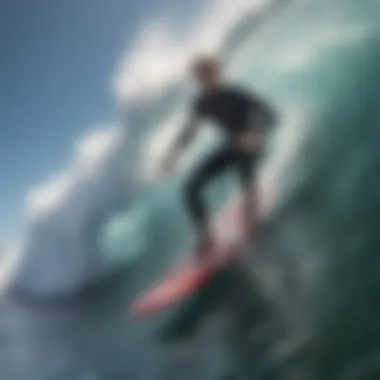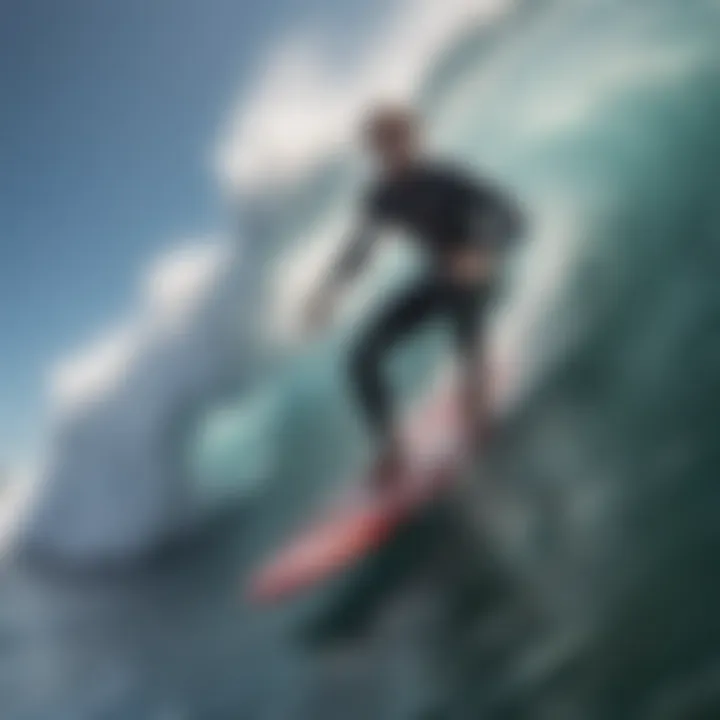Enhancing Your Surfing Journey: Techniques and Gear


Intro
Surfing is more than just a sport; it's a symphony of skill, nature, and community. Enhancing the surfing experience involves a delicate balance of techniques, innovations, and awareness of the environment. This comprehensive guide seeks to unravel the recommended methods, equipment, and mental strategies that can elevate every surfer’s experience, whether you're a beginner looking to stand up for the first time or an advanced rider chasing the perfect wave.
Surfboarding Techniques
Beginner Tips for Mastering the Basics
Starting with the fundamentals is crucial for any aspiring surfer. Here are some techniques that can pave the way to a fulfilling surfing journey:
- Positioning: Start by lying flat on your board, keeping your weight evenly distributed. This will help you balance, making it easier to pop up to a standing position.
- Popping Up: When you feel a wave lift your board, firmly plant your hands on the board and spring up swiftly, landing with your feet shoulder-width apart. Practice this on land to build muscle memory.
- Paddle Technique: Efficient paddling is key to catching waves. Keep your arms straight, using a smooth motion to minimize water resistance.
- Wave Selection: Understanding which waves to ride takes time. Look for waves that break cleanly. Always prioritize safety—watch for other surfers and any potential hazards in the water.
Once you’ve mastered these basics, progress will feel more natural, ultimately leading to a richer surfing experience.
Advanced Techniques for Seasoned Surfers
For those with a firm grasp on the basics, the next step is to refine advanced skills:
- Cutbacks: This maneuver allows you to change direction quickly while riding a wave. Use your back foot for control, pivoting your board to create tight arcs in your turns.
- Aerials: Going airborne is an exhilarating part of surfing. It requires perfect timing and commitment. Approach the section of the wave that’s steep enough, and as you ascend, pull the board up and into the air, landing smoothly.
- Tube Riding: This is the holy grail of surfing. To successfully navigate inside the barrel, stay low and centered over your board, maintaining speed while scanning ahead to anticipate the wave’s movement.
With practice, these techniques can substantially increase your performance, allowing you to truly connect with the water and waves you ride.
Surfboard Equipment
Reviews of the Latest Surfboards on the Market
Having the right equipment is as important as mastering techniques. Here are some innovations to consider:
- Firewire Surfboards: Known for their eco-friendly construction, Firewire combines performance and sustainability. Their use of advanced materials has contributed to the overall durability and responsiveness of the board.
- Lost Surfboards: Known for their performance-oriented designs, these boards suit a variety of conditions and skill levels. Their unique shapes allow for dynamic movement and fluid transitions in the water.
- Red Paddle Co. Inflatable Boards: Perfect for those venturing into new locations, these inflatable boards are portable and easy to store. Despite their inflatable nature, they offer stability and performance comparable to hard surfboards.
These boards not only provide options that heighten your experience but also cater to different skill levels and surfing styles.
Essential Gear for Every Surfboarder
Aside from the board itself, here's a rundown of gear essential for surfers:
- Wetsuit: Depending on your climate, invest in a high-quality wetsuit that offers insulation while allowing for ease of movement.
- Leash: Never skimp on a reliable leash—this will keep your board close during wipeouts, minimizing the risk of injury.
- Wax: A good base of wax on your board increases traction. Different types of wax exist depending on water temperature, so choose wisely.
- Travel Bag: For those who journey far and wide to chase waves, a travel bag will protect your board while in transit.
"The ocean stirs the heart, inspires the imagination, and brings eternal joy to the soul."
As you navigate through your surfing journey, remember that enhancing your experience is an ongoing process of learning and adapting. Pay heed to the methods and equipment discussed, engage with the community, and respect the natural environment that makes surfing so special.
Understanding the Basics of Surfing
Surfing isn’t just a pastime; it’s a way of life for many who are drawn to the ocean. Understanding the fundamentals of surfing lays the foundation for a rewarding experience. It encapsulates not just the techniques but the philosophies that elevate one's time spent on the waves. Being familiar with the core elements of surfing, including history, equipment, and basic skills, is crucial for both beginners and seasoned surfers looking to enhance their capabilities.
The Evolution of Surfing
Surfing, as we know it today, finds its roots tracing back to ancient Polynesian culture where wave riding was not merely a sport but a cherished tradition. As surfing spread globally, it has adopted and integrated diverse styles and approaches. Changes in societal attitudes towards sport, recreation, and connection with nature have shaped surfing’s evolution. There has been a noticeable shift from traditional methods to the modern innovations we witness today. This gradual transformation highlights how surfing has grown into a beloved sport across the globe, catering to various skill levels and preferences.
Different Types of Surfboards
The kind of surfboard you choose can dramatically affect your performance and enjoyment on the water. Here’s a closer look at the different types of surfboards:
Shortboards
A hallmark of progressive surfing, shortboards are known for their maneuverability and speed. Typically between 5’6" and 6’4", their narrower design allows for quick turns and radical tricks. This makes them particularly popular among advanced surfers who aim to push the limits. However, they require a higher skill level to ride effectively, and beginners might struggle with the fast turns and unstable balance.
Longboards
In contrast to shortboards, longboards generally range from 8’ and can go as long as 12’. They offer a more forgiving ride, emphasizing stability over maneuverability. Beginners often favor them for their ease of use, making it simpler to catch waves. Longboards allow surfers to practice classic styles, like noseriding, offering a slower, smoother experience that many find aesthetically pleasing. However, their size can make it challenging in crowded lineups and smaller surf conditions.
Fish Boards
Fish boards, with their unique swallowtail design, are short and wide, providing excellent floatation. They cater to a different riding style, making them suitable for small to medium-sized waves. Their design allows for swift turns and a playful surfing experience. Ideal for those who enjoy riding smaller waves, fish boards excel under conditions where traditional shortboards struggle. However, they are less effective in larger, more powerful surf.
Hybrid Boards
Hybrid boards blend the benefits of both shortboards and longboards, combining speed with stability. This versatility makes them suitable for a broad range of surfers. They feature a variety of tail shapes and fin setups, allowing for experimentation in riding styles. A hybrid surfboard can often be tailored to personal preference or adaptability to changing wave conditions. While they provide flexibility, their hybrid nature might not excel in specialized surfing scenarios compared to dedicated board types.
Fundamental Surfing Techniques
Mastering the basic techniques of surfing is essential for boosting the overall experience. Ensuring that a surfer is well-versed in these skills leads to greater confidence and competence in the water.


Paddling
Paddling is more than just moving through the water; it’s an essential technique that dictates positioning and wave catching. Effective paddling means using an efficient stroke, which promotes longer sessions without fatigue. Explorations into timing during paddling can significantly enhance a surfer's ability to position themselves for a successful take-off. Poor paddling can lead to missed waves and increased exhaustion, diminishing enjoyment.
Positioning
Positioning on the board can be pivotal during a session. It requires a discerning balance between being too far forward and risking a nosedive or being too far back, causing missed waves. A well-positioned surfer maximizes their chances of catching waves while maintaining control. Understanding how to shift weight depending on wave conditions plays a significant role in the overall surfing efficiency. Those who overlook positioning may find themselves struggling to ride successfully.
Take-off Maneuvers
Take-off maneuvers are the gateway to wave riding. The technique involves timing and the ability to read waves accurately. Understanding when to paddle harder, and being able to push up quickly cannot be underestimated. An effective take-off sets the stage for a good ride, allowing surfers to harness the wave's energy effectively. Mastering this skill is often what separates beginner surfers from intermediates, as it requires keen practice and awareness.
"The ocean offers endless opportunity for those willing to learn the craft of surfing – from understanding the waves to mastering each ride."
Through grasping the basics, a surfer not only enhances their own experience but also cultivates a deeper appreciation for the ocean and the culture surrounding the sport. This foundational knowledge underscores the importance of continuous practice and immersion in the surfing world.
Enhancing Surfing Skills
Enhancing surfing skills is pivotal not only for improving performance but also for a deeper connection with the waves. Whether a novice or a seasoned rider, developing the right skills can transform your time on the water. It involves honing technical proficiency and understanding the mental and physical aspects of the sport. Key points to consider include the solid foundation of fitness, mental toughness, and practicing advanced techniques, all of which collectively elevate the surfing experience.
Physical Conditioning and Fitness
Physical conditioning lays the groundwork for not just success in surfing but also for enjoying the sport to the fullest. Surfers use their entire bodies, requiring strength, balance, and endurance. Focusing on these areas can significantly enhance a surfer's performance.
Strength Training
Strength training plays an essential role in improving overall power on the board. It fortifies a surfer’s core, legs, and upper body, directly impacting how well one can paddle, pop up, and execute maneuvers. The key characteristic of strength training is its ability to cultivate functional strength that translates to better performance on waves. A convenient choice for many surfers, strength training diminishes the risk of injury while enhancing muscle endurance. Unique features of this approach include its flexibility; it can be tailored to fit varying skill levels. However, it does require a commitment to regular workouts to see significant improvements.
Balance Exercises
Balance exercises form the backbone of a surfer's agility on the water. These drills enhance one’s stability, critical for maintaining position on a moving board. The key characteristic of balance training is that it can mimic the unstable conditions one encounters while surfing, making it particularly effective. The beauty of balance exercises lies in their accessibility; options range from simple ones at home to more complex movements using stability balls or balance boards. Despite their advantages, they sometimes require a bit of time to show noticeable improvement in surfing skills.
Cardiovascular Fitness
Cardiovascular fitness cannot be overlooked, as it directly correlates with a surfer's stamina in the water. The key characteristic of aerobic conditioning is its ability to sustain energy levels, allowing surfers to paddle out longer and tackle more challenging waves. This area of fitness is popular because it supports not just surfing but also general health. Engaging in activities like running or swimming builds a robust cardiovascular foundation. Understanding one’s limits is key with this approach, as overexertion can lead to fatigue or injury, detracting from the surfing experience.
Mental Preparation for Surfers
Mental preparation is often the unsung hero behind great surfing performances. The psychology of surfing can heavily influence results, and addressing one's mental state is essential for optimal performance.
Visualization Techniques
Visualization techniques are a powerful mental tool for surfers. It involves imagining oneself riding a wave, feeling the balance and flow. The key characteristic of this method is that it creates a mental blueprint for success during actual rides, boosting confidence. This technique is sought after because it enhances focus and clarity when it’s time to hit the waves. A unique feature of visualization is its capacity to help surfers prepare for different situations they might face in the water. However, it may come less naturally to those not familiar with such mental practices, requiring a bit of discipline to implement effectively.
Mindfulness Practices
Mindfulness practices help surfers remain present, reducing distractions from the oceanic environment. The key characteristic of mindfulness is that it fosters clarity and calmness, allowing surfers to focus better on their technique and surroundings while paddling and riding. Its popularity stems from the mental ease it brings, with many surfers integrating practices like meditation into their pre-surf routines. Such techniques bring peace but might be challenging to maintain consistently, especially during high-pressure situations.
Overcoming Performance Anxiety
Overcoming performance anxiety involves tackling the nerves that can creep in before or during surfing sessions. The key characteristic of this process is developing coping strategies to stay relaxed and focused in high-pressure environments. This method is crucial, as anxiety can lead to subpar performance and enjoyment. Unique features include incorporating breathing exercises and positive affirmations. While advantageous, this journey may require trial and error to find what works best individually, bringing challenges along the way.
Advanced Maneuvers and Techniques
Mastering advanced maneuvers and techniques separates great surfers from the rest. Learning these tricks not only builds skills but adds excitement to the riding experience.
Cutbacks
Cutbacks are a dynamic move that allows a surfer to redirect back to the pocket of the wave. The key characteristic of this technique is that it demonstrates a surfer's ability to read the wave, a skill crucial for all types of surfing. This maneuver is a favorite among those seeking to add flair to their rides. One unique feature is the feeling of control and flow it brings, enhancing the overall surfing experience. However, it requires practice to ensure smooth execution without losing speed—something that can be frustrating at first.
Floater Techniques
Floater techniques turn a surfer into a wave’s master by riding over the face of the wave at high points. The key characteristic is that it showcases the ability to maintain speed while minimizing drag. It is a celebrated move in the surfing community since it conveys a sense of freedom on the wave. The thrill of floating enhances the ride significantly. Yet, this technique can be challenging due to the timing and balance needed to execute it correctly—inattentiveness could lead to wipeouts.
Barrel Riding
Barrel riding represents the ultimate goal for many surfers; it allows them to shoot through the hollow of a wave. The key characteristic here is the adrenaline rush it provides, making it a pinnacle of accomplishment. This technique’s uniqueness lies in how it connects with the wave, demanding split-second decisions and exceptional balance. It’s popular among thrill-seekers yet requires a high level of skill and understanding of wave dynamics, which can create a steep learning curve for inexperienced surfers.
Innovations in Surf Equipment
In the realm of surfing, the equipment one chooses can dramatically affect both performance and enjoyment. Modern innovations in surf gear have tailored equipment to meet the dynamic needs of surfers, enhancing their overall experience on the waves. With advancements in materials, design, and maintenance practices, surfers can make informed choices that elevate their skills and sustainability. This section will immerse you in the essential innovations reshaping surf equipment, covering materials used, design principles, and upkeep practices.
Materials and Technology Advancements


Epoxy vs. Polyester
When comparing Epoxy and Polyester surfboards, it’s crucial to understand how each material behaves under pressure. Epoxy boards are generally lighter and stronger than their polyester counterparts. This characteristic not only provides improved buoyancy but also resilience against impacts. Surfers tend to gravitate toward these boards for their ability to hold their shape longer, which means they can withstand more wear and tear.
However, polyester boards have their strengths as well. These boards are often more affordable and widely available, making them a practical option for beginners or those on a budget. Yet, they may not retain performance quality as long as epoxy boards, thus requiring more frequent replacements.
Carbon Fiber Reinforcements
Carbon fiber has emerged as a game-changer in surfboard construction. This material significantly enhances the rigidity of boards without adding substantial weight. The key attribute of carbon fiber is its unparalleled strength-to-weight ratio. This means that surfers enjoy improved performance without feeling weighed down.
The unique feature of carbon fiber reinforcement allows for boards that flex in ways that maximize speed and agility while also maintaining structural integrity. However, the cost can be prohibitive for some, limiting its use to more seasoned surfers or enthusiasts who prioritize high performance.
Eco-Friendly Alternatives
As surfing culture increasingly embraces sustainability, eco-friendly alternatives to traditional materials have gained traction. Options like recycled foam and bio-resins are now being explored to lessen environmental impact. The standout quality of these materials is their potential to minimize pollution and waste, making them a responsible choice for the environmentally conscious surfer.
By adopting eco-friendly boards, surfers not only support innovative practices but also influence the industry towards more sustainable solutions. However, the availability and performance comparability to traditional materials can sometimes be lacking, so one must consider personal values and preferences carefully.
Surfboard Design for Performance
Tail Shapes
Tail shape is often an overlooked yet vital factor in surfboard performance. Different designs, whether it be a rounded tail for smooth turns or a square tail for sharp edges, directly influence how the board reacts on the wave. The key advantage of customizing tail shapes is the ability to cater to specific surf conditions and personal styles.
For example, a swallow tail may excel in control during fast rides, while a pintail is known for smooth turns in larger swells. Each unique feature presents its own set of benefits and trade-offs, making it essential for surfers to understand their intended use to maximize performance.
Rockers and Contours
The rocker of a surfboard describes its curve from nose to tail. A board with a significant rocker can maneuver quickly through critical sections of a wave, allowing for tight turns. Conversely, a flatter board offers speed and stability.
Choosing the right rocker can enhance a surfer's ability to match their skill level with wave conditions. While a pronounced rocker can improve maneuverability, it may sacrifice speed, spatial awareness is crucial.
Fin Configurations
Fin configurations play a pivotal role in surfboard performance and handling. Different setups, such as thrusters, quads, or single fin options, cater to various styles and wave types. The main benefit of experimenting with fin placements lies in the surfer’s ability to fine-tune control and responsiveness. Each configuration brings its own set of advantages and disadvantages that can drastically change a ride.
A thruster setup offers a balance between stability and maneuverability, ideal for a mix of conditions. On the other hand, a quad setup can provide speed and drive. Therefore, knowing your riding style and the sort of waves you frequent can guide your fin selection.
The Impact of Board Maintenance
Regular Inspections
Routine inspections of your surfboard can extend its life significantly. By checking for any small cracks or dents frequently, surfers can catch problems before they escalate. The key benefit of these inspections lies in prevention—avoiding costly repairs while ensuring better performance at every session.
Ignoring minor damages can lead to larger issues, so dedicating time for care can ensure your board remains in optimal shape.
Repairs and Damage Prevention
Tips for keeping a board in top form include applying sealant to small scratches and storing it properly. Frequent repairs can help mitigate further damage, allowing surfers to maintain their boards in excellent condition. This diligence results in better performance and enjoyment whenever hitting the water.
However, each repair might require specific techniques and products, making it crucial to understand what works best for your board type.
Storage Recommendations
Lastly, the way you store your surfboard can influence its longevity. Avoid exposing it to extreme heat or sunlight, which can warp the shape and weaken the materials. Proper storage recommendations often include keeping the board in a padded bag and storing it upright.
These simple actions can significantly prevent any long-term structural issues, ultimately ensuring that each ride is as good as the last.
"Investing in your surf equipment goes beyond the purchase; it’s about understanding the technology and maintaining it for peak performance on every wave."
By delving into the innovations within surf equipment, surfers are not just upgrading their gear; they are enhancing their entire surfing experience, leading to greater joy and sustainability in the sport.
Environmental Considerations
Discussing environmental considerations holds significant weight in enhancing the surfing experience. Surfers inherently engage with nature, riding the waves generated by the ocean, so the preservation of these natural wonders is paramount. By being cognizant of ecologically sound practices, surfers can help maintain the integrity of their sport and the environments they love. From choosing sustainable gear to participating in clean-up events, every action counts in ensuring the health of marine ecosystems.
Sustainable Surfing Practices
Choosing Eco-Conscious Gear
Choosing eco-conscious gear involves selecting surfboards and accessories made from sustainable materials. This commitment doesn’t just reduce harm to the environment; it also supports a growing market that prioritizes sustainability. Boards crafted from renewable materials or those utilizing innovative processes reduce waste and pollution.
A notable feature of eco-conscious surfboards is the use of bamboo or recycled plastics. These materials not only contribute to lower carbon footprints but are durable and performance-oriented. As such gear becomes more mainstream, its popularity rises among surfers seeking to align their passion for riding the waves with ethical considerations.


Reducing Plastic Use
The idea of reducing plastic use directly ties into the collective effort of surfers to safeguard our oceans. Single-use plastics pose a risk to marine life and the overall quality of water. Emphasizing alternatives like metal or glass is a pivotal step in this direction. The beauty of this approach is its simplicity — by opting for products free of plastic or reducing consumption, surfers can significantly impact the health of the oceans.
When surfers are mindful of their plastic consumption, they not only help to cut down on ocean pollution but also inspire those around them. An enticing feature of this practice is the promotional aspect; many surfers display their commitment to sustainability both in their choice of gear and community actions. However, the challenge lies in changing long-standing habits and adapting to new routines.
Participation in Clean-Up Events
Partaking in clean-up events signifies a hands-on approach to environmental stewardship. By joining forces with local organizations or surf clubs, surfers physically contribute to the health of marine zones, directly benefiting their surfing grounds.
The essence of participation is community building; it brings surfers together and fosters a culture of ecological responsibility. The unique aspect of these events is that they shift the narrative from passive enjoyment of nature to active guardianship. The downside? The time commitment can sometimes deter involvement, but the rewards often outweigh the effort, creating a deeply rewarding experience that connects surfers to their environment.
Marine Conservation for Surfers
Understanding Local Ecosystems
Understanding local ecosystems is crucial for surfers and the longevity of their sport. By familiarizing themselves with the marine life and habitats surrounding their surfing spots, surfers can adjust their practices to minimize harm. This includes understanding seasonal changes in wildlife patterns and respecting no-wake zones.
An important feature of this awareness is the ability to advocate for ecological balance. Surfers who understand the dynamics of local environments know how to navigate their activities in harmony with nature. The adaptation of behaviors based on ecological knowledge can contribute significantly to safeguarding local marine life.
Supporting Conservation Initiatives
Supporting conservation initiatives empowers surfers to be part of broader ecological commitments. Whether through funding, volunteering, or advocacy, engaging with local conservation efforts strengthens the overall impact on marine environments.
A key characteristic of these initiatives is that they often provide surfers with the knowledge and tools needed to make informed decisions. The unique benefit lies in the shared experience; often, connecting with others who are passionate about marine preservation leads to friendships and community ties. On the flip side, there can be overwhelming options for involvement which might confuse newcomers on where to begin.
Advocating for Environmental Policies
Advocating for environmental policies enables surfers to influence the direction of marine conservation on a larger scale. By being vocal and informed about pressing environmental issues, surfers can push for legislative changes that protect ocean habitats.
The strength of this advocacy is its potential reach; collective voices can inspire significant political or social changes. This aspect not only helps cultivate awareness but also establishes surfers as responsible stewards. However, it requires a commitment to remaining informed and engaged with ongoing environmental challenges that can feel like a heavy burden for some but is essential for sustainable surfing.
Community Engagement and Surf Culture
Surfing isn’t merely a sport; it embodies a vast culture and shared experience that revolves around waves, beaches, and the people who engage in these activities. Community engagement plays a vital role in shaping the surfing experience, fostering connections, and amplifying shared values among surf enthusiasts. This article examines the significance of community participation and the vibrant surf culture that emerges from it, highlighting the numerous benefits and considerations involved.
Building a Supportive Surf Community
Local Surf Clubs
Local surf clubs are, in many ways, the heartbeat of surfing. They serve as hubs for both beginners and seasoned surfers, acting as meeting points for people with a common interest. The key characteristic of these clubs is their focus on promoting a sense of belonging among members, which is crucial for growing one's skills and confidence in surfing.
The unique feature of local surf clubs is their ability to foster camaraderie – a sense of togetherness that often leads to better surfing experiences. They frequently organize surf sessions, competitions, and workshops that not only help improve skills but also strengthen social ties. The drawback, though, can be the occasional clique behavior where some clubs might feel exclusive, potentially deterring newcomers.
Mentorship Programs
Mentorship programs in the surfing community are invaluable, guiding newcomers through the often-challenging waters of surfing proficiency. These initiatives pair less experienced surfers with seasoned veterans, facilitating a knowledge transfer that is personal and practical. A key benefit is the personalized support these programs offer; they're tailored to individual learning curves and challenges.
The unique aspect of mentorship in surfing is the bond that forms between a mentor and mentee. It goes beyond just sharing technical skills; it often includes life lessons that foster resilience and determination. However, finding the right mentor can be tough, leading to mismatches in character or understanding, which can hinder the growth process.
Online Forums and Communities
In this digital age, online forums and communities have made it easier than ever to connect with fellow surfers, regardless of geographical barriers. These platforms serve as conversational stages where surfers of all levels share tips, experiences, and insights. The primary characteristic of these online spaces is their accessibility, allowing individuals to engage at their convenience.
What sets these communities apart is the vast array of experiences and backgrounds they encompass. It’s common to find discussions on everything from gear reviews to surf spot recommendations. However, the downside is the potential for misinformation. Not all advice shared is accurate or applicable to everyone; thus, users should critically evaluate the information before adopting it.
Promoting Inclusivity in Surfing
Adaptive Surfing Initiatives
Adaptive surfing initiatives are breaking barriers and creating avenues for those with disabilities to participate in surfing. This movement showcases the evolving nature of surfing, emphasizing that waves belong to everyone. A notable characteristic is the provision of specialized equipment and trained instructors to assist individuals in experiencing surfing safely and joyfully.
The unique feature of adaptive surfing programs is the empowerment they offer. By enabling individuals to ride waves, these initiatives foster a sense of accomplishment and belonging. A challenge, however, is the availability of resources and trained personnel in various regions, which may limit participation.
Women in Surfing
The contribution of women to the surfing landscape cannot be overstated. Historical biases often overshadowed women's presence in surfing; however, recent years have seen a welcome change. Initiatives to highlight women surfers and support their growth have become increasingly prevalent. The crucial aspect is the promotion of equal opportunities and visibility for women.
Women's success stories in surfing contribute to breaking stereotypes, inspiring future generations of female surfers. Nevertheless, there remains a considerable gap in representation within competitive surfing, and this requires ongoing commitment from the community to address among surf culture.
Support for Marginalized Communities
Support for marginalized communities in surfing aims to level the playing field, allowing everyone, regardless of background, access to the joys of surfing. The critical characteristic is the focus on equity, providing resources and platforms for underrepresented groups to engage in surfing activities.
The unique feature of this support lies in the community-driven approach, often involving local organizations that understand the needs of these groups. However, it often faces challenges in securing consistent funding and resources to maintain positive outreach and impact, which can make it difficult to sustain long-term initiatives.
"A strong community is a tide that lifts all boats, fostering shared experiences and growth that can change lives for the better."
By cultivating a thriving, engaged surfing community that champions inclusivity, the surfing experience becomes richer, not just for individuals, but for the sport as a whole. The elements discussed above emphasize the importance of fostering connections, sharing knowledge, and supporting one another within the surf culture.















